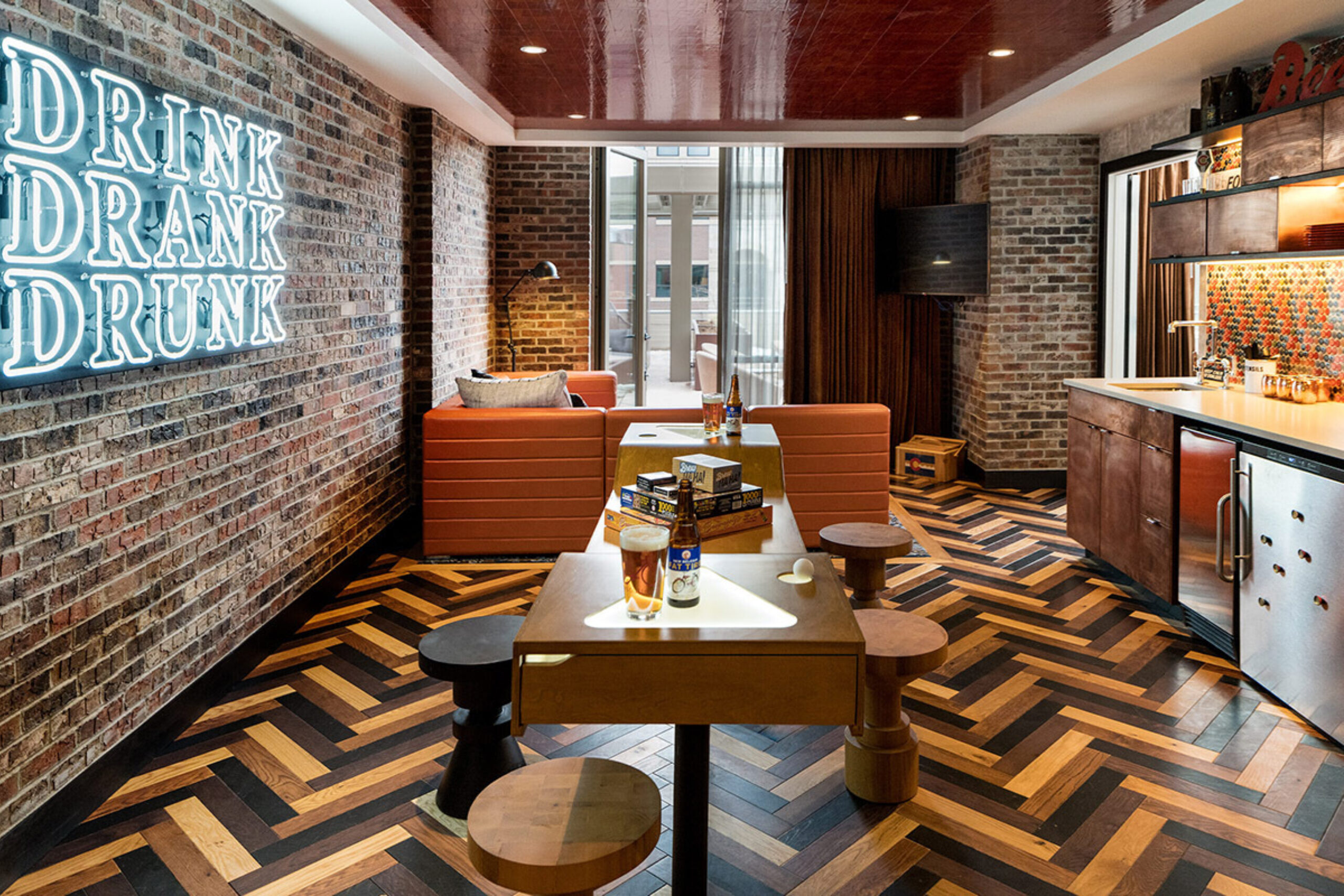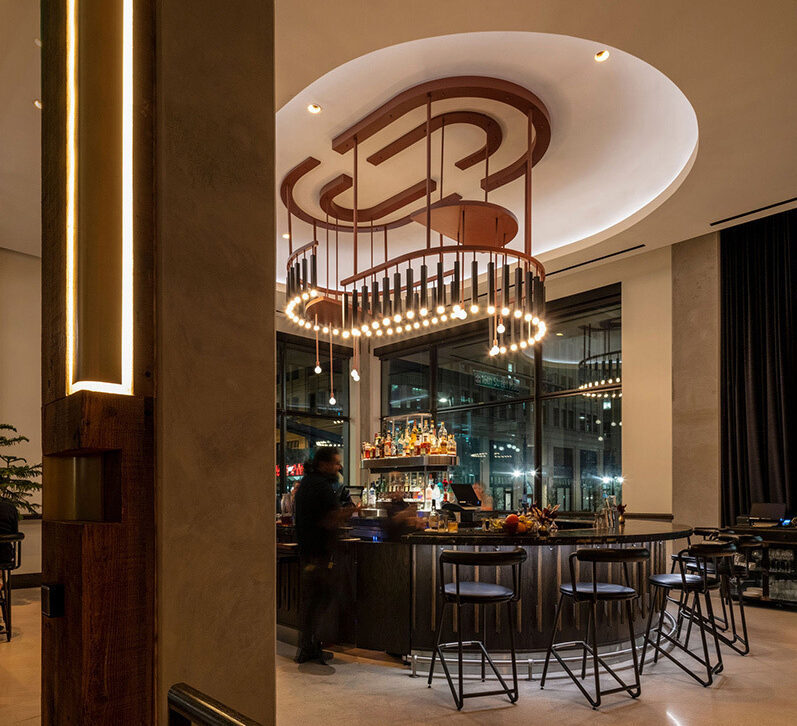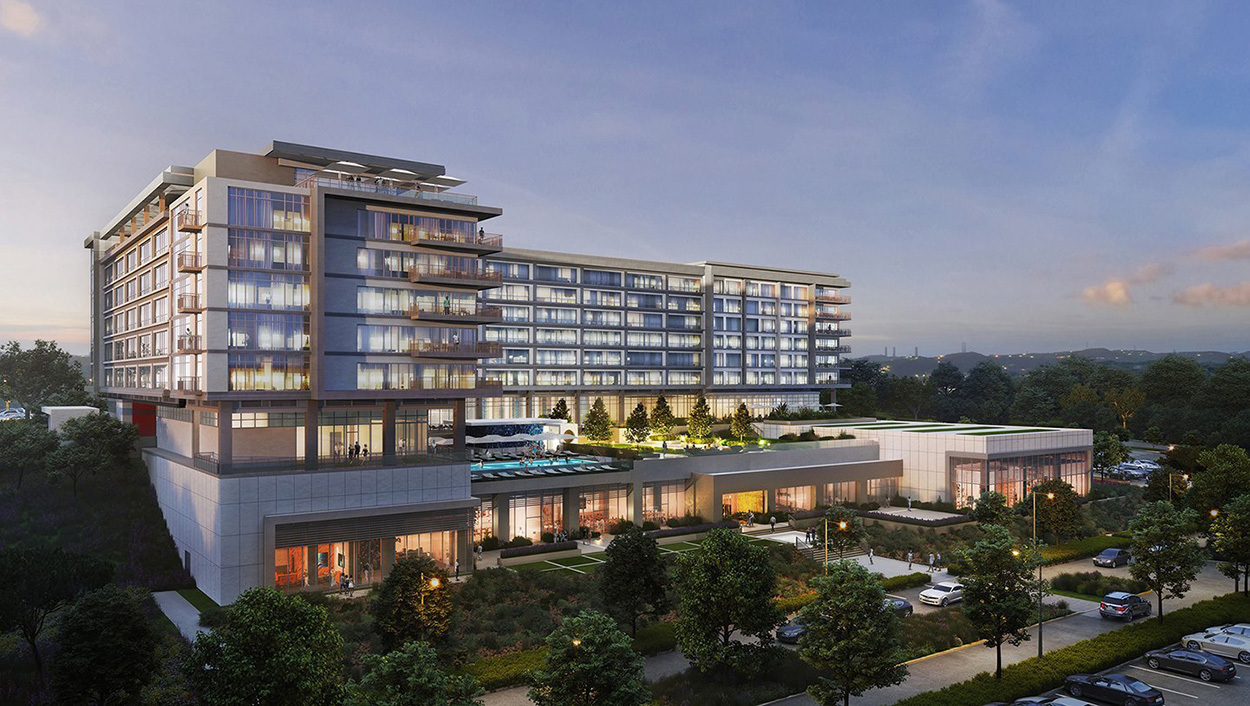Frequently Asked Questions in Hospitality Design – Hotel Lighting

Lighting design plays an essential role in setting the tone for the guest experience in a hospitality environment. Whether it's a lobby’s welcoming glow, a dramatic restaurant or lounge feature or a beautifully functional guest room, the lighting in each space colors the memory guests take with them.
Hotel designs naturally run the gamut – warm and inviting, sleek and modern, rustic and natural – but regardless of the design intent, successful lighting must serve the design as a whole, enhancing the narrative that is being crafted through the architecture, interior design and brand identity.
In this series, we’re diving into the factors that make for successful hospitality lighting, drawing on LS Group’s experience on everything from luxe mountain resorts to chic urban boutique hotels.
Let’s talk mountain resorts. How can a project’s lighting strategy complement a ski-town feel: the harmonious blend of outdoor adventure and cozy respite?
Modern mountain resort design transcends traditional rusticity, but often the goal is the same: to use natural materials and textures to provide guests with a warm, welcoming and comfortable retreat that both celebrates and provides a respite within nature. The architectural allure of mountain resorts serves as more than a backdrop; it becomes a conduit for evoking a sense of warmth and nostalgia. After a day on the hill, the lodge typically serves as a gathering place for après and conversation, often around a large fireplace element.
Our goal as lighting designers is to optimize this ambiance and design intent, particularly in communal spaces. Strategic diffused ambient lighting, complemented by well-choreographed accent lighting that complements natural textures and architectural elements, sets the tone for the experience. The illumination of ceilings or walls can envelop the space in a soft glow, resulting in an environment where guests feel cocooned in comfort, fostering an appreciation of the mountains' beauty and the charm of the space itself.
What are the unique challenges and opportunities of lighting a mountain resort?
Mountain resorts are typically set in breathtaking natural landscapes. Designing lighting that enhances the environment without disrupting the natural beauty can be both a design opportunity and a challenge, as many towns have light pollution ordinances that prevent a certain level of illumination on the exterior. Strategic lighting placement can highlight scenic views, integrate indoor and outdoor spaces and even bring the outside in, enhancing guests' connection to nature.
Inside, the architecture in mountain resorts typically focuses on celebrating honest materiality in some form or fashion, so there tends to be a strong focus on highlighting wood, natural stone, and water and fire features. Lighting these spaces is complicated, but exciting as there is always a different texture or nook to consider. Complex architectural angles can additionally present challenges, creating shadows or uneven lighting, requiring us to configure innovative solutions to ensure consistent illumination.

Switching gears, let’s talk boutique hotels. There is so much variety out there, what are some keys to successfully lighting these highly specialized environments?
Design for boutique hotels is incredibly varied, so we need to be well-versed in both the technical and aesthetic opportunities - whether it’s a historic mansion turned six-room hotel or a modern new build. In these bespoke environments, the lighting colors, temperatures and decorative fixtures can vary widely from space to space and are truly customized to the location and design. The key to a successful lighting design in these settings is the seamless integration of lighting with architecture and interiors; making lighting part of the lived-in, felt environment, rather than an afterthought. We collaborate with the interior and architectural teams early in the process to develop a lighting plan that is thoroughly integrated into the space.
At The Elizabeth’s Pre-Function space, we meticulously planned a lighting story that featured six different, but subtle, layers of light – downlighting, sconces, tape light, decorative chandeliers and more. Highlighting this beautiful corridor with so many various approaches was not to go over the top, in fact, the opposite, they are hardly distinguishable at a glance. Creating a feeling of balance is always our priority.
Another example of designing for these bespoke spaces is our work at The Thompson, where the beautiful, oval-shaped bar cove is up-lit to naturally highlight the oval canopy above. This type of visual connection between the architectural and interior components of a space and the lighting design creates a strong sense of place.
With a boutique hotel, smart lighting controls can be a powerful tool in creating dynamic environments from day to night. We can adjust lighting scenes, colors and intensity in rooms from day to day or season to season. This flexibility helps us create these highly customized environments, which can be a defining component of the boutique experience. We also see more adaptable lighting systems utilized and reconfigured to suit different uses. This might include movable fixtures, track lighting or modular systems that further enhance flexibility.

So, when the goal is to create a more consistent experience for a global brand, how can lighting design be used to infuse a local feel while still adhering to corporate standards?
A primary goal for our design for global brands is to elevate the unique identity of each project while fastidiously adhering to its brand standards.
A global hotel brand often sets core standards around lighting style to create consistent lighting experiences across all hotel locations while allowing for flexibility in implementation. That consistency of experience is key for them. That said, a hotel in Miami will likely have elements that localize it and differentiate it from one in Chicago.
The corporate standards often stick to the technical. Unlike the texture and color-way direction you might need to adhere to for the interior design, for lighting, brand standards will specify make-up of decorative, indirect and task lighting, but are often open to letting a local team of designers guide the local flavor and aesthetics. In this case, we’re still hitting all the technical marks but can extrapolate per market as the resident expert.
We are currently underway with the Hotel Polaris at the Air Force Academy, a Coral Tree hotel.
The goal is to align the corporate brand with the feel of the surrounding elements of Colorado Springs and, particularly, the local culture of the Air Force Academy.
When you understand the unique components that define a location, such as architectural styles, local materials and cultural nuances, you can incorporate artful nods to the location while simultaneously aligning with brand standards.
What are some of the challenges of working within these types of standards?
Corporate standards often come with strict guidelines that must be adhered to, including specific lighting requirements aligned with the brand's image and identity. Unlike boutique hotels that might have more leeway in terms of design choices, working within these standards provides some parameters. However, as designers, we know there is power in the creative constraint. So, we work to strike a balance between meeting the brand's guidelines and infusing the space with distinctive elements that reflect the hotel's individuality.
Within this challenge is the sub-challenge of designing for the masses, versus designing for individuals. Considering the number and diversity of people who pass through a hotel, the lighting really has to work for everyone, across generations and preferences.
Working with a global brand additionally involves multiple layers of feedback from various stakeholders. With many different eyes on the design, it is particularly important to ensure lighting metrics and values like photometrics, foot-candles are paired with clear visual representations to demonstrate lighting levels. Clarity of communication and design, meticulous attention to detail and seamless working relationships are integral to navigating the complexities in the decision-making and approval processes.
What are some of the best practices for energy-efficient lighting design, no matter the type of hospitality setting?
We continue to see a push towards ever more sustainable lighting practices, with more advanced LEDs and autonomous controls. LEDs consume significantly less energy than traditional incandescent or fluorescent bulbs and have a longer lifespan, reducing maintenance costs while lowering energy consumption. Smart, autonomous lighting controls manage lighting based on occupancy, daylight levels or specific schedules.
These systems are particularly valuable in commercial settings – which utilize much more energy than residential – and allow for precise control and optimization of lighting, reducing unnecessary usage and maximizing energy savings. Control systems are not something to be afraid of. While they have the capacity to be complicated, an incredibly simple and energy-efficient lighting system is attainable. The bells and whistles can seem fun for the tech-obsessed, but all you really need is basic dimmers, control system equipment paired and an app.
From the inviting warmth of mountain resorts to the eclectic charm of boutique hotels and the standardized yet culturally attuned environments of global brands, each of the hospitality environments we work in presents its own set of challenges and opportunities. But no matter where we’re designing, the biggest key to success is seamless teamwork with our clients and partners. We strive on every project for a design that perfectly balances functionality and aesthetics to create unforgettable guest experiences within the project's timeframe and budget!
